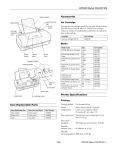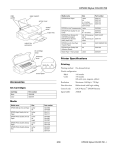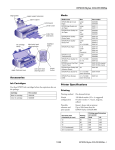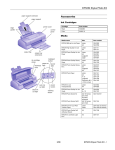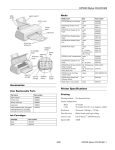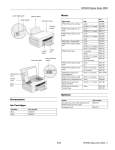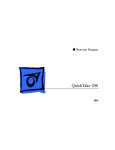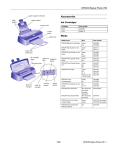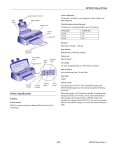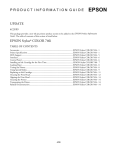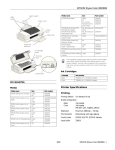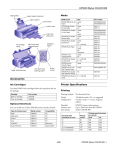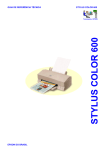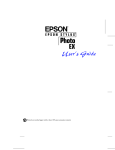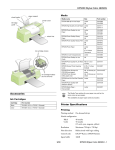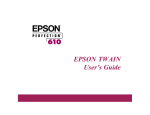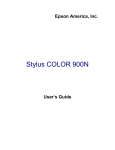Download Epson 700 Printer User Manual
Transcript
Contents Welcome! Everything You Need for Photo-Quality Prints What Is Your Printer Software? What Is EPSON Digital PhotoLab? Printer Setup Unpack the Printer Attach the Paper Support Install the Ink Cartridges Connect the Printer to Your Computer Load Paper Install the Software Register Your Printer EPSON Digital PhotoLab Navigating Through EPSON Digital PhotoLab What Do You Get with EPSON Digital PhotoLab? Print a Page in Windows Print a Page in Macintosh Problems? Need Help? 1 1 1 1 2 2 3 3 5 6 7 15 15 16 18 19 23 27 iii Comoro+ GS Booklet 3 3/17/98, 4:34 PM Welcome! Your EPSON Stylus® Photo 700 is the ideal printer for optimum photo-quality printing—print any image from your favorite photos to letters and everyday documents. Everything You Need for Photo-Quality Prints The EPSON Stylus Photo 700 CD-ROM includes all the software you need for photo-quality output: your printer software and EPSON Digital PhotoLab™. What Is Your Printer Software? To print, you need some printer software (also known as a printer driver) to tell the printer how to print. This software is what you use to select settings that control the look of your documents. A step-by-step guide to printing starts on page 19 for Windows® and on page 23 for Macintosh®. What Is EPSON Digital PhotoLab? To help you get the most out of your printer, EPSON Digital PhotoLab includes award-winning photo-editing, photoorganizing, and photo-layout software. This creative software collection is described in more detail on page 15. 1 Comoro+ GS Booklet 5 3/17/98, 4:34 PM Printer Setup Setting up your printer is easy. Just follow the simple steps on the following pages. Before you set up your printer, make sure your system meets the requirements listed in the Introduction of your User’s Guide. 1 Unpack the Printer Remove any packing material from the printer. See the Notice Sheet in the box for details. Save all the packaging so you can use it if you need to transport the printer later. You need the following items to set up your printer: ■ paper support Your printer and paper support ■ Ink cartridges (black and color) ■ CD-ROM with your printer software and EPSON Digital PhotoLab ■ Printer cable (not included) color ink cartridge printer black ink cartridge CD-ROM (located on the back of this guide) Note: To connect to a PC, you’ll need a shielded, twisted-pair parallel printer cable (6 to 10 feet long). To connect to a Macintosh, you’ll need an Apple® System Peripheral-8 cable (Belkin brand recommended). Place the printer flat on a stable desk near a grounded outlet. Leave plenty of room in back for the cables and enough room in front for opening the output tray. Do NOT put the printer: 2 ■ In an area with high temperature or humidity ■ In direct sunlight or dusty conditions ■ Near sources of heat or electromagnetic interference, such as loudspeakers or cordless telephone base units. Be sure to follow all the Safety Instructions in your User’s Guide. Comoro+ GS Booklet 6 3/17/98, 4:34 PM 2 Attach the Paper Support Insert the paper support in the top slot on the back of the printer. 3 Install the Ink Cartridges power light 1. Plug the power cord into a grounded outlet. 2. Make sure the power is off (the power light is off). Caution: Don’t use an outlet controlled by a wall switch or timer, or one that uses the same circuit as a large appliance. This may disrupt the power, which can erase memory or even damage the power supply. power button printer cover 3. Lower the output tray and open the printer cover. power button output tray 3 Comoro+ GS Booklet 7 3/17/98, 4:34 PM 4. Press the power button to turn on the printer. The power light flashes, the black and color ink out lights come on, and the ink cartridge holders move left to the installation position. Caution: Always use the power button to turn the printer on or off. Never use an external switch—such as a power strip—to turn off the printer. 5. Lift the two ink cartridge clamps. 6. Remove the ink cartridges from their foil packages. Then remove only the yellow part of the tape seal on the top of each cartridge. Do not remove the white part. Caution: You must remove the yellow tape seal from the top of the cartridge or you will permanently damage it. It’s OK if the tape does not tear off exactly along the dotted line. Do not try to remove the clear seal from the bottom. don’t remove don’t remove remove remove black ink cartridge color ink cartridge Warning: If ink gets on your hands, wash them thoroughly with soap and water. If ink gets in your eyes, flush them immediately with water. 4 Comoro+ GS Booklet 8 3/17/98, 4:34 PM 7. Insert the ink cartridges into their holders. Be sure the labels are face up and the arrows point toward the back of the printer. The black ink cartridge goes on the left and the color ink cartridge goes on the right. 8. Push down the clamps until they lock in place. 9. Press the cleaning button and close the printer cover. The printer moves the print head and begins charging the ink delivery system. Charging can take two to four minutes. During this time, the power light flashes, and the printer makes various sounds. Don’t turn off the printer or interrupt the charging process or you’ll use more ink than necessary. Charging is complete when the power light stops flashing and stays on. Caution: Never turn off the printer when the power light is flashing. But if the light is still flashing after five minutes and the printer isn’t moving or making noise, you may turn off the printer. 4 Connect the Printer to Your Computer Connecting to a PC 1. Turn off the printer and your computer. 2. Connect the cable to the printer’s parallel interface; then squeeze the wire clips together to lock them in place. (If your cable has a ground wire, connect it now.) 3. Connect the other end of the cable to your computer’s parallel port and secure it as necessary. Note: The printer is automatically assigned to parallel port LPT1; if you want to use a different port, see your Windows documentation for instructions. 5 Comoro+ GS Booklet 9 3/17/98, 4:34 PM Connecting to a Macintosh 1. Turn off the printer and your Macintosh. 2. Connect the cable to the serial connector on the back of the printer. 3. Connect the other end of the cable to either the modem port or the printer port on your Macintosh. Note: If you’re using a PowerBook™ with a combination printer/modem port, use that port and select modem in the Chooser. Make sure AppleTalk® is inactive before turning on the printer. 5 Load Paper 1. Slide the left edge guide all the way to the left and pull out the output tray extensions. 2. Fan a stack of plain paper and then even the edges. left edge guide 3. Load the stack with the printable surface face up. Push the paper against the right edge guide. output tray extensions Note: Don’t load paper above the arrow mark inside the left edge guide. Keep unused paper in its original packaging and store it in a cool, dark place. 6 Comoro+ GS Booklet 10 3/17/98, 4:35 PM 4. Slide the left edge guide against the paper stack. Don’t load paper above this mark. Note: If you like, you can run a test on your printer to see how it’s working. Follow the steps in Chapter 6 of your User’s Guide. 6 Install the Software Your EPSON Stylus Photo 700 CD-ROM includes printer software (also called a printer driver) and EPSON Digital PhotoLab for both Windows and Macintosh. You must install the printer software for the printer to work correctly. Note: If you don’t have a CD-ROM drive, you can use another computer with a CD-ROM drive to make printer driver diskettes. See page 29 for instructions. You can also order the printer driver software on diskettes (see the inside back cover for instructions) or download it from http://www.epson.com. You need a CD-ROM drive to install and use EPSON Digital PhotoLab; it is not available on diskettes. 7 Comoro+ GS Booklet 11 3/17/98, 4:35 PM Installing the Software for Windows 95 or Later 1. Make sure your printer is connected to the computer and that both are turned off. 2. Turn on your computer, but leave your printer turned off. Make sure Windows 95 is running (you should see the Windows Desktop icons). 3. Insert the EPSON Stylus Photo 700 CD-ROM or diskette 1 if you’re using diskettes. If Windows 95 launches the installation program automatically, you see the EPSON Setup CD window. Go to step 4. If it doesn’t launch automatically, click Start, select Run, and type D:\Setup700 (substitute the correct drive letter if it is not D). Then click OK. You see the EPSON Setup CD window. Go to step 4. If you are installing from diskettes, type A:\SETUP (substitute the correct drive letter if it is not A). Then click OK. Go to step 5. 4. At the EPSON Setup CD window, make sure Initial Installation is selected and click Next. Note: If you are installing the software for the first time, Initial Installation is your only option. If you are reinstalling the software, you can select Install EPSON Digital PhotoLab or Reinstall EPSON Printer Software. If you click Exit Setup during the installation, you skip the EPSON Digital PhotoLab installation and proceed directly to the printer software installation. 8 Comoro+ GS Booklet 12 3/17/98, 4:35 PM 5. Follow the instructions on screen to install the software. EPSON Digital PhotoLab is installed first. Click Finish when that installation is complete. At the next screen, click OK to install your printer software and Status Monitor. (There may be a brief pause before the installation begins; if you are installing the software from diskettes, only the printer software and Status Monitor are installed.) Be sure to click Next to install the Status Monitor. When the installation is complete, you must reboot your computer for the Status Monitor to take effect. Your printer software and EPSON Digital PhotoLab icons appear in the EPSON folder and an icon for your printer appears in the Printers folder. The EPSON Stylus Photo 700 printer is set as your default Windows printer. An icon for EPSON Digital PhotoLab also appears on your desktop. To launch this program, double-click the icon. For details about EPSON Digital PhotoLab, see page 15. 6. Turn your printer on. Note: If your computer is on a network and the printer is connected to a remote server, you now need to set up the computer as a client. See Appendix A of your User’s Guide for instructions. Caution: If you’re setting up your computer for the first time, you may see a message asking if you want to install a printer. Be sure to select Cancel and complete your Windows 95 setup. If at any time you see the New Hardware Found screen and Windows 95 asks you to insert a driver diskette, always select Cancel. You can’t install your software that way. 7. Continue with “Register Your Printer” on page 15. 9 Comoro+ GS Booklet 13 3/17/98, 4:35 PM Installing the Software for Windows 3.1 1. Make sure your printer is connected to the computer and your computer is turned on. 2. Make sure Windows Program Manager is running. Exit any open applications. 3. Insert the EPSON Stylus Photo 700 CD-ROM or diskette 1 if you’re using diskettes. 4. From the Program Manager File menu, select Run. 5. If you are installing from the CD-ROM, type D:\Setup700, click OK, and continue with step 6. If you are installing from diskettes, type A:\SETUP, click OK, and continue with step 7. (If your drive uses a different letter, substitute it for D or A.) 6. At the EPSON Setup CD Window, make sure Initial Installation is selected and click Next. Note: If you are installing the printer software for the first time, Initial Installation is your only option. If you are reinstalling the software, you can select Install EPSON Digital PhotoLab or Reinstall EPSON Printer Software. If you click Exit Setup during the installation, you skip the EPSON Digital PhotoLab installation and proceed directly to the printer software installation. 10 Comoro+ GS Booklet 14 3/17/98, 4:35 PM 7. Follow the instructions on screen to install the software. EPSON Digital PhotoLab is installed first. Click Finish when that installation is complete. At the next screen, click OK to install your printer software. (There may be a brief pause before the installation begins; if you are installing the software from diskettes, only the printer software is installed.) Your printer software icons and the EPSON Digital PhotoLab icon appear in the EPSON program group and the EPSON Stylus Photo 700 is set as your default Windows printer. To launch EPSON Digital PhotoLab, click this icon in the EPSON program group. For details about this program, see page 15. 8. Continue with “Register Your Printer” on page 15. Installing the Software for Windows NT® 4.0 If you’ve connected the printer to your Windows NT 4.0 print server, you need to install the EPSON printer software on the server. Then set up the workstations to share the printer. You don’t need to install the printer software on any Windows NT 4.0 workstations if the printer software is installed on the server. Note: Check your Windows NT 4.0 documentation for instructions on sharing the printer on workstations running other operating systems, such as MS-DOS®. 1. Turn on the printer. 2. Turn on your computer and log on to Windows NT 4.0 with the appropriate access privileges. 11 Comoro+ GS Booklet 15 3/17/98, 4:35 PM 3. Insert the EPSON Stylus Photo 700 CD-ROM or diskette 1 if you’re using diskettes. If Windows NT 4.0 launches the installation program automatically, you see the EPSON Setup CD window. Go to step 4. If it doesn’t launch automatically, click Start, select Run, and type D:\Setup700 (substitute the correct drive letter). Then click OK. You see the EPSON Setup CD window. Go to step 4. If you’re installing from diskettes, click Start, select Run, and type A:\SETUP. Then click OK. Go to step 5. 4. At the EPSON Setup CD window, make sure Initial Installation is selected and click Next. Note: If you are installing the printer software for the first time, Initial Installation is your only option. If you are reinstalling the software, you can select Install EPSON Digital PhotoLab or Reinstall EPSON Printer Software. If you click Exit Setup during the installation, you skip the EPSON Digital Photolab installation and proceed directly to the printer software installation. 12 Comoro+ GS Booklet 16 3/17/98, 4:35 PM 5. Follow the instructions on screen to install the software. EPSON Digital PhotoLab is installed first. Click Finish when that installation is complete. At the next screen, click OK to install your printer software. (There may be a brief pause before the installation begins; if you are installing the software from diskettes, only the printer software is installed.) Your printer software icons appear in the EPSON folder and an icon for your printer appears in the Printers folder. An icon for EPSON Digital PhotoLab appears on your desktop. To launch this program, double-click the icon. For details about the program, see page 15. 6. Follow the instructions in your Windows NT 4.0 documentation to set up the workstations to share the printer. 7. Continue with “Register Your Printer” on page 15. Installing the Software on a Macintosh 1. Make sure your printer is connected to your Macintosh and both are turned off. 2. Turn on your Macintosh and turn off your virus protection programs, as necessary. 3. Once your Macintosh is fully started, turn on your printer. 4. Insert the EPSON Stylus Photo 700 CD-ROM or Disk 1 if you’re using diskettes. Double-click the EPSON CD-ROM or diskette icon if it doesn’t open automatically. 5. If you’re installing from the CD-ROM, double-click the Printer Software Installer icon. If you’re installing from diskettes, double-click the Installer icon. Then click Continue. Note: If you are installing your software for the first time, you must install the printer software before you install EPSON Digital PhotoLab. 13 Comoro+ GS Booklet 17 3/17/98, 4:35 PM 6. Click Install for the default installation (Easy Install) and follow the instructions on screen to install the printer software and utilities. After the printer software installation is complete, you must reboot your Macintosh. Then you can continue with the EPSON Digital PhotoLab installation. 7. Double-click the EPSON Digital PhotoLab Install icon and follow the instructions on screen to install it. An alias for EPSON Digital PhotoLab appears on your desktop and EPSON Digital PhotoLab automatically launches. To launch this program again later, double-click the alias. For details about the program, see page 15. 8. Continue with “Selecting Your Printer” in the next section. Selecting Your Printer After you install the software, you need to select your printer using the Chooser. Note: If you are using a Quadra 950 or 900, you must choose Compatible in the Control Panels, Serial Switch dialog box before selecting your printer in the Chooser. 1. Open the Chooser from the Apple menu. 2. Click the SP 700 icon. 3. Click the icon for the port where you connected your printer. 4. Make sure AppleTalk is inactive if your printer is connected to the printer port. Note: You can activate AppleTalk only if AppleTalk or the Network Control Panel is set to Ethernet or Remote Only. 5. Turn on background printing if you want to run print jobs and use your Macintosh at the same time. (This may slow down printing and Macintosh processing.) 6. Continue with “Register Your Printer” in the next section. 14 Comoro+ GS Booklet 18 3/17/98, 4:35 PM Register Your Printer Take a minute to register your printer with EPSON. Locate the registration card that came in your printer box. Then fill it out and mail it to us. EPSON Digital PhotoLab We’ve packed lots of fun and informative software in with your printer. EPSON Digital PhotoLab contains a collection of photo-editing, photo-organizing, and photo-layout software. Install any one or all of them, depending on your preferences and the space available in your computer. We’ve also included a variety of terrific project ideas for your photos, such as T-shirts, banners, greeting cards, and other items you might never have thought of! Plus, you can get helpful information on EPSON products and supplies. Be sure to run the EPSON Digital PhotoLab software suite right away to install your creative software and check out the great projects. Here’s how... ■ In Windows 95 or Windows NT 4.0, double-click this icon on the desktop or select EPSON Digital PhotoLab from the Start, Programs, EPSON folder. ■ In Windows 3.1, open your EPSON program group. Then double-click this icon: . ■ On a Macintosh, double-click the EPSON Digital PhotoLab alias your desktop. on Note: If the EPSON Digital PhotoLab icon doesn’t appear, you may not have installed it when you installed your printer software. Reinsert your CD-ROM and follow the installation instructions. If you selected Run from CD-ROM when you installed EPSON Digital PhotoLab, you must have your CD-ROM in the CD-ROM drive. For optimum viewing, set your monitor to 256 colors. 15 Comoro+ GS Booklet 19 3/17/98, 4:35 PM Navigating Through EPSON Digital PhotoLab In the main menu, you can select from the following: ■ INSTALL ADDITIONAL PROGRAMS. This section contains a collection of award-winning software. ■ PHOTO WORKSHOP. See this section for cool project ideas and fun photo products. ■ PHOTOS ON THE NET. Check out this section to see the EarthLink® Internet service provider offer, learn how to navigate the net, and find photo-savvy web sites. Also includes the Kodak® Picture Network. ■ SCOOP ON OTHER EPSON PRODUCTS. Find out about EPSON digital cameras, scanners, and the wide variety of EPSON media. ■ HOW TO GET HELP. If you need help with any of these programs, see this section for information on contacting the software manufacturers. This bar is not active; click EXIT to return to the desktop Main menu selections 16 Comoro+ GS Booklet 20 3/17/98, 4:35 PM After you select an item from the main menu, you’ll see a submenu. To return to the main menu, click EPSON. To return to your desktop, click EXIT. Click to quit EPSON Digital PhotoLab and return to the desktop Click to return to the main menu Many of the submenus have tabbed sections. Select a section by clicking its tab. Click DONE to return to the submenu screen. (You cannot click EPSON or EXIT when you’re in a tabbed section.) Click to open a section Click to view the next page in section Click to return to the submenu Not active Not active 17 Comoro+ GS Booklet 21 3/17/98, 4:35 PM What Do You Get with EPSON Digital PhotoLab? Select INSTALL ADDITIONAL PROGRAMS to install these great programs on your system: Windows 95 Windows 3.1 Windows NT 4.0 Macintosh Adobe® PhotoDeluxe® 2.0 EPSON Photo Sheet™ Extensis™ Portfolio™ 3.0 Pictureworks™ Spin™ Panorama DíAMAR® Learning to See Creatively LE Follow the instructions on screen to install the programs. For more information about a program, see its online help utility. 18 Comoro+ GS Booklet 22 3/17/98, 4:35 PM Print a Page in Windows Now that you’ve set up your printer and installed the software, you’re ready to print. Follow the steps below to use Adobe PhotoDeluxe on Windows 95 to print a color image. (If you haven’t installed Adobe PhotoDeluxe from the CD-ROM yet, go ahead and install it now.) Note: These printing instructions are for Windows 95, but you can use the same basic steps to print with most applications on other operating systems. Before you print, you may need to change your printer settings from within your application. Whenever you print, be sure to check the Media Type and Quality/Speed settings in your printer software to make sure they’re correct for your print job. See your User’s Guide for a complete description of all the printer settings. In Windows NT 4.0, click Start, select Settings, and then choose Printers. Right-click the EPSON Stylus Photo 700 icon and click Properties. On the Scheduling tab, select Print directly to the printer and click OK. 1. Make sure your printer and computer are turned on. Also make sure you’ve loaded 8.5 x 11-inch plain paper in the printer. 2. Open Adobe PhotoDeluxe. 3. Select an image to print. Click the Get Photo button. Then click the Get Photo tab. ... then click here Click here first... 19 Comoro+ GS Booklet 23 3/17/98, 4:35 PM 4. Adobe PhotoDeluxe contains a wide selection of sample images. Click Open File and highlight the file name for the image you want to print (you may need to navigate to the folder with your file) and click Open. Select your image here Click here 5. Click File in the menu bar and select Print from the list that appears. 6. You see the Print dialog box. Click the Setup button. Click here 20 Comoro+ GS Booklet 24 3/17/98, 4:36 PM 7. You see the Page Setup dialog box. Click the Properties button. Click here 8. You see the dialog box for your printer software. If necessary, click the Main tab to display the basic settings shown below. Main tab This setting gives good printing results for most types of documents Move the slider to choose between higher resolution or faster printing Click here to select the type of media you’ve loaded in the printer Click OK after you select your basic settings 21 Comoro+ GS Booklet 25 3/17/98, 4:36 PM 9. Check the following settings: ■ Set the Mode option to Automatic; the printer software optimizes the other settings according to the media type and ink settings you make. Or you can click the Advanced button and select one of the predefined Custom Settings. See Chapter 2 in your User’s Guide for details. ■ Move the Quality/Speed slider to the Quality setting. This changes the print quality shown in the Current Settings box at the bottom of the window to Fine - 720 dpi. (The slider is not available if you are using a custom setting.) ■ Make sure Media Type is set to Plain paper. (If you load a different type of paper, you need to select a corresponding Media Type.) 10. Click the Paper tab if you want to print more than one copy or if you want to change the page orientation (for more information, see your User’s Guide). 11. Click the Layout tab if you want to change the layout (for more information, see your User’s Guide). 12. Click OK twice to close the printer software and Page Setup dialog boxes and return to the Print dialog box. 13. Click OK to start printing. If you installed the Status Monitor, the Progress Meter will appear and show the progress of your print job. For more information, see Chapter 4 in your User’s Guide. Soon you’ll see the amazing photographic detail your EPSON Stylus Photo 700 printer can produce. 22 Comoro+ GS Booklet 26 3/17/98, 4:36 PM Print a Page in Macintosh Now that you’ve set up your printer and installed the software, you’re ready to print. Follow the steps here to use Adobe PhotoDeluxe to print a color image. (If you haven’t installed Adobe PhotoDeluxe from the CD-ROM yet, go ahead and install it now.) If you are using a different program, the steps you need to print may vary from those below. 1. Make sure your printer and computer are turned on. Also make sure you’ve loaded 8.5 x 11-inch plain paper in the printer. 2. Open Adobe PhotoDeluxe. 3. Select an image to print. Click the Get Photo button. Click here 4. Click the Get Photo tab. Then click the Open File button. Click here 23 Comoro+ GS Booklet 27 3/17/98, 4:36 PM 5. Adobe PhotoDeluxe contains a wide selection of sample images. Highlight the file name for the image you want to print (you may need to navigate to the folder with your file) and click Open. 6. Now open your printer software to get ready to print the image. Click File in the menu bar and select Page Setup from the list that appears. 7. You see the page setup dialog box. Make any changes you want to the paper size or orientation, then click OK to close the dialog box. 24 Comoro+ GS Booklet 28 3/17/98, 4:36 PM 8. Click File again and select Print. You see the print dialog box. Move the slider to choose between higher resolution or faster printing Click Print after you select your settings This setting gives good printing results for most types of documents Click here to select the type of media you’ve loaded in the printer 9. Check the following settings: ■ Make sure the Mode option is set to Automatic; the printer software optimizes the other settings according to the media type and ink settings you make. Or you can click the Advanced button and select one of the predefined Custom Settings. See Chapter 2 in your User’s Guide for details. ■ Move the Quality/Speed slider to the Quality setting. This changes the print quality shown in the Current Settings box to Fine - 720 dpi. (The slider is not available if you are using a custom setting.) ■ Make sure Media Type is set to Plain Paper. (If you load a different type of paper, you’ll need to select a corresponding Media Type.) 10. Click Print to start printing. If you have background printing turned on, EPSON Monitor3 opens in the background to monitor your print job. See Chapter 4 of your User’s Guide for more details about Monitor3. Soon you’ll see the amazing photographic detail your EPSON Stylus Photo 700 printer can produce. 25 Comoro+ GS Booklet 29 3/17/98, 4:36 PM 26 Comoro+ GS Booklet 30 3/17/98, 4:36 PM Problems? Need Help? Here are some basic troubleshooting tips if you have any problems setting up your printer or using the software. You can also turn to Chapter 6,“Troubleshooting,” in your User’s Guide or look in your printer software online help. If you’re having problems installing your printer software . . . If you see the “New Hardware Found” screen in Windows 95, click Cancel. You cannot install your printer software that way. Make sure your printer is turned on and the printer cable is securely connected to the printer and computer. Make sure you’ve closed all other applications, including any screen savers. Then try installing the software again. If you need help with the creative software in EPSON Digital PhotoLab . . . For assistance using the programs you installed with EPSON Digital PhotoLab, contact the company that produced the software. For contact information, launch EPSON Digital PhotoLab. Then click HOW TO GET HELP. If you installed the ink cartridges and the printer started making noise . . . The first time you install ink cartridges, the printer must charge its state-of-the-art ink delivery system. Charging can take two to four minutes. Please wait until charging is finished before you turn off the printer. If you turn off the printer while it is charging, it will begin charging the system again and use up more ink than necessary. 27 Comoro+ GS Booklet 31 3/17/98, 4:36 PM If your printer makes noise when you turn it on or after it has been sitting for a while . . . Your printer is performing routine maintenance. If you can’t see the EPSON Progress Meter or Status Monitor 2 in Windows 95 . . . Make sure you installed the Status Monitor. If you didn’t, you can install the Status Monitor by reinstalling the printer software and making sure you choose to install the Status Monitor. If you installed the Status Monitor, make sure it is turned on. See Chapter 4 of your User’s Guide for details. If your printout is faint or has gaps in the image . . . Make sure your paper isn’t loaded face down (the printable surface should be loaded face up), damaged, old, or dirty. If it is, reload a new stack of paper with the printable side up. Your print head nozzles may need cleaning. For instructions, see Chapter 5 of your User’s Guide. If your printout is blurry . . . Check the thickness lever position. If it’s in the + position, your printer is set for thicker paper or envelopes and your image may smear. For most papers, set the thickness lever to the 0 position. Make sure your paper isn’t damp or loaded face down (the printable surface should be loaded face up). If it’s damp, reload a new stack of paper. 28 Comoro+ GS Booklet 32 3/17/98, 4:36 PM If your printout contains incorrect characters . . . Your printer’s interface cable may not be securely connected. Check that the cable is locked firmly in place at both ends to ensure proper communication between your printer and computer. After adjusting the cable, try printing from an application again. Your printer may not be selected as the Windows default printer or as the current printer in the Macintosh Chooser. ■ For instructions on selecting the Windows default printer, see your Windows documentation or Windows online help. ■ To select your printer in the Macintosh Chooser, see “Selecting Your Printer” on page 14. If you need to make printer driver diskettes from the CD-ROM . . . To make printer driver software installation diskettes from the CD-ROM using another computer, see the section below for your operating system. Note: You need a CD-ROM drive to install and use EPSON Digital PhotoLab; it is not available on diskettes. 29 Comoro+ GS Booklet 33 3/17/98, 4:36 PM Making PC Diskettes 1. Prepare two blank formatted diskettes and label them diskette 1 and diskette 2. 2. Make sure Windows is running. 3. Insert the EPSON Stylus Photo 700 CD-ROM. 4. In Windows 95 or Windows NT 4.0, the installer program starts automatically and you see the EPSON Setup CD window. (If it doesn’t start, click Start, select Run, and type D:\Setup700 [substitute the correct drive letter]; then click OK.) In Windows 3.1, select Run from the File menu. Then type D:\Setup700 (substitute the correct drive letter) and click OK. 5. At the EPSON Setup CD screen, click the Make Diskettes button. Select your operating system and click OK. Follow the instructions on screen to create the diskettes. Use the diskettes you created to install the printer software on your computer. See page 7 for instructions. Making Macintosh Diskettes Before making diskettes from the CD-ROM, name the formatted diskettes you’ll use Disk 1 and Disk 2, using a capital “D” and a space between Disk and the number. If they’re not named correctly, the diskettes won’t be able to install your software. 1. Turn on the Macintosh and turn off any virus protection programs, as necessary. 2. Insert the EPSON Stylus Photo 700 CD-ROM. 3. Double-click the EPSON CD-ROM Disk 1 folder. 4. Insert the diskette you named Disk 1. 5. Select all the icons in the CD-ROM Disk 1 folder and drag them to the Disk 1 icon on your desktop. 6. After the files have been copied, eject Disk 1. Then repeat steps 3 through 5 for the Disk 2 folder and diskette. Use the diskettes to install the printer software on your Macintosh. See page 13 for instructions. 30 Comoro+ GS Booklet 34 3/17/98, 4:36 PM How to order printer software diskettes from EPSON You can order printer driver software diskettes from EPSON by phone or fax for $9.95 shipping and handling (plus tax where applicable), or you can download the diskette image files. When you’re ready to install your printer software, see page 7 for Windows instructions or page 13 for Macintosh instructions. Download: ■ EPSON Web Page: Point your browser to http://www.epson.com/connects and select File Downloads (FTP) ■ EPSON Internet FTP Site: Log on to ftp.epson.com with the user name anonymous and your e-mail address as the password ■ Epson America Forum on CompuServe®: Click on Services . . Go, then type EPSONFOR in the dialog box ■ EPSON Download Service: Set your modem’s communications software to 8 data bits, 1 stop bit, no parity, and a maximum speed of 28.8 Kbps. Then dial the EPSON BBS at (800) 442-2007 If you need downloading instructions, call EPSON’s FaxAdvice™ service at (800) 442-2110 and request document #1220; be sure to supply a return fax number Fax: Send the following information by fax to EPSON at (310) 782-5266: ■ Name and Company name Street address (no P.O. boxes please) City, State and ZIP code ■ Daytime telephone number ■ Payment method (VISA, MasterCard, or American Express) Card number and expiration date Be sure to sign your fax; it is required for the credit card purchase ■ Printer name (EPSON Stylus Photo 700) ■ Operating system (Windows 95, Windows 3.1, Windows NT 4.0, or Macintosh) Phone: Call (310) 533-8467 from 6 AM to 6 PM Pacific time, Monday through Friday EPSON and EPSON Stylus are registered trademarks of SEIKO EPSON CORPORATION. EPSON FaxAdvice, EPSON Digital PhotoLab, and EPSON Photo Sheet are trademarks of Epson America, Inc. General Notice: Other product names used herein are for identification purposes only and may be trademarks of their respective owners. EPSON disclaims any and all rights in those marks. Printed on recycled paper with at least 10% post-consumer content. Copyright © 1998 by Epson America, Inc. Comoro+ GS Booklet 35 3/98 3/17/98, 4:36 PM How to Order EPSON Ink and Paper To order EPSON ink cartridges, paper and other printing media, contact your dealer or call EPSON Accessories at (800) 873-7766 (U.S. sales only). In Canada, please call (800) 873-7766 for dealer referral. Here are the EPSON ink cartridges and media you can order: Media name Size Part number EPSON 360 dpi Ink Jet Paper Letter (100 count) A4 (100 count) S041060 S041059 EPSON High Quality Ink Jet Paper Letter (100 count) A4 (100 count) S041111 S041117 EPSON Photo Quality Ink Jet Paper Letter (100 count) A4 (100 count) Legal (100 count) S041062 S041061 S041067 EPSON Photo Quality Glossy Paper Letter (20 count) A4 (20 count) S041124 S041126 EPSON Photo Quality Glossy Film Letter (15 count) A4 (10 count) A6 (10 count) S041072 S041071 S041107 EPSON Photo Paper 4 x 6 (20 count) Letter (20 count) A4 (20 count) Panoramic, pre-cut, 8.3 x 23.4 inches (10 count) S041134 S041141 S041140 S041145 EPSON Ink Jet Transparencies Letter (30 count) A4 (30 count) S041064 S041063 EPSON Photo Quality Ink Jet Cards A6 (50 count) 8 x 10 (30 count) S041054 S041122 EPSON Photo Sticker Kit S041144-KIT EPSON Photo Sticker Refill A6, 5 sheets, 16 frames per sheet (includes software) A6, 5 sheets, 16 frames per sheet S041144 EPSON Iron-On Cool Peel Transfer Paper Letter (10 count) Letter (50 count) S041153 S041155 EPSON Photo Quality Self Adhesive Sheets A4 (10 count) S041106 Ink cartridge Part number Black ink cartridge S020093 Color ink cartridge S020110 Comoro+ GS Booklet 2 3/17/98, 4:34 PM

































